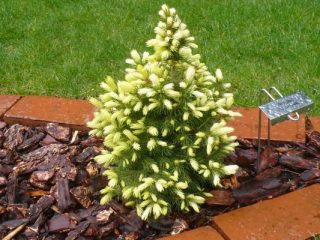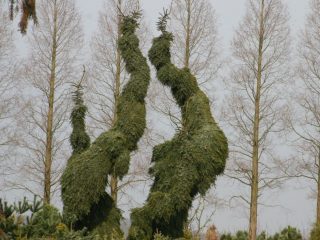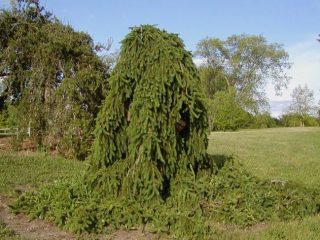Content
A spruce hedge is an original type of fencing that looks much more aesthetically pleasing than a fence made of mesh, corrugated boards or boards. It is formed for the purpose of zoning the site or its decorative framing. This type of hedge is very popular among gardeners and landscape designers and has become quite fashionable in recent years. In addition, it is not difficult to make a spruce fence with your own hands; you just need to plant the required number of trees and take proper care of them.

A hedge can be made from different plants, but it looks especially beautiful from spruce trees.
Pros and cons of spruce hedges
A fence made of evergreen trees, in addition to its spectacular appearance, has a number of advantages and minor disadvantages, which are still taken into account when choosing this type of fencing.

A spruce fence helps to securely cover the area from prying eyes
Advantages:
- maintaining attractiveness all year round;
- providing dense shade;
- enrichment of air with phytoncides;
- creating protection from dust, wind and snow drifts;
- durability;
- possibility of cultivation in the northern regions;
- large selection of varieties;
- ease of care.
Flaws:
- slow growth;
- the need for frequent molding in the early years;
- high price of adult seedlings;
- fire hazard;
- possible oppression of neighboring plants.
Varieties of fir trees for hedges
In nature, there are a huge number of different varieties of spruce trees, differing in color, size, needles and other parameters. Almost every variety is suitable for creating a hedge, but in Russia, Norway spruce is most often planted for this purpose. It is well adapted to the climatic conditions of the country, its seedlings are not particularly expensive, caring for it is simple, any gardener can cope with it.
The type of conifer for creating a hedge is usually chosen taking into account its characteristics and ability to withstand regular pruning. For example, to create a green trellis-type fence, it is best to give preference to varieties such as Inversa, Acrocona, Ohlendorffii, and Cupressina. These spruce trees have dense branches, a cone shape, and their height is from 4 to 15 meters. The varieties are undemanding and perform well even when planted densely. In cases where a hedge of medium height is needed, it is better to plant species such as Barryi or Frohburg. They grow up to a maximum of two meters.
For those who want to make an unusual hedge, the spruce variety Will's Zwerg, which is characterized by a weeping crown, is suitable. Such a frame will become an original decoration of any garden.And if you need to create a dividing line or border from conifers, the varieties Echiniformis and Little Gem will best cope with this task. These are dwarf trees, no more than 50 cm in length, with a cushion-shaped or hemispherical crown.
DIY spruce hedge
A hedge made of Scots spruce (photo below), in terms of years of service, is noticeably superior to green fences made from any other plant crops, which is why it is found in gardening more often than others. You can do it yourself without resorting to the help of specialists. If you carry out the work according to the instructions, then within a few years it will delight the owner with its beauty, and the brightness and richness of the colors can be observed regardless of the season. Even in winter, a site with such a hedge will have a festive and spectacular look. It is often used to create relaxation areas where you can always relax and enjoy the clean air.

Spruce is a long-lived tree and a hedge made from it will last at least 30-40 years
Landing dates
The crop is planted at the moment when it enters its dormant period. This usually occurs in spring (April-May) and early autumn (until mid-October). With the second planting option, it is important to plant it so that the plant has time to take root before the onset of frost.
Selection of seedlings
Since ornamental spruce trees are usually used for hedges, which, due to the loss of maternal characteristics, are not propagated by seeds, gardeners have to purchase them in stores. It is advisable that this be a specialized nursery or seller who has earned a good reputation. Preference should be given to specimens 3-4 years old, which are the best to start growing and take root in a new place without any problems.
If you plan to make a hedge from spruce trees from the forest, then you need to dig them up immediately on the day of planting. The shorter the interval from the moment the tree is removed from the forest soil to replanting, the better.
Soil preparation
Due to the fact that as little time as possible should pass between spruce transplants, it is advisable to prepare the area for the hedge in advance, otherwise you need to act quickly. Since the crop likes to grow on loamy or sandy soil, preference should be given to such soil, although, according to gardeners, it takes root on almost any substrate. After the place for the hedge has been determined and a trench has been dug for it, it is advisable to soften its bottom by adding river sand and peat. In the case of close groundwater, you will need to take care of the drainage layer. To do this, add at least 5 cm of broken brick or crushed stone to the trench, and then fill it with substrate.

Conifers grow calmly in the shade, but can get severe burns from direct sunlight
Scheme for planting a hedge of spruce trees
A spruce hedge is planted according to the following scheme:
- Mark the area with a cord where the fence will be placed.
- Dig a trench as deep as a shovel along the marking and moisten it.
- Dip the roots of each seedling into a mixture of manure and powdered clay and plant it so that the root collar of the plant is flush with the surface of the ground.
- Fill the trench with peat chips and humus in a 1:1 ratio, water it, and mulch the top with sawdust.
The distance between spruce trees when planting a hedge is observed depending on the size of the crop variety and the purpose of the fence:
- border up to 0.5 m high - the distance between rows is about 50 cm, between trees - 30 cm;
- fence from 150 to 300 cm - interval between seedlings 80-100 cm, row spacing from 2 to 3 m;
- wall more than 3 m - both distances from 2.5 m.
Further care
After planting, spruce in a hedge requires compliance with care rules, which consist of the following actions:
- Watering. The plant does not like hot weather, so in the summer months it is advisable to moisten it weekly, spending 15 to 50 liters of water on each tree. The rest of the time, when the weather outside is cool, there will be enough rainfall for the spruce hedge.
- Loosening. Since the root system of the crop is superficial, it is necessary to loosen the soil where it grows carefully, to a depth of no more than 10 cm. It is recommended to carry out the work once every three weeks.
- Fertilizer. It is advisable to feed young trees up to 15 years old 3-4 times a year, from April to August. It is best to use nitrogen-containing compounds for this. In October, it is recommended to apply phosphorus fertilizer. Adult spruce trees are fed in May and mid-autumn with complex products for coniferous crops.
- A haircut. Pruning of spruce in a hedge begins when the tree grows to the desired height. Usually the procedure is performed 1-2 times per season. Before this, the crown is pinched every year so that the plant grows wider.

The required height and density of the green fence is adjusted by trimming the tree
Conclusion
A spruce hedge is a very popular way to frame a site made in any style. The options have a wide variety due to the fact that plant varieties vary in height, crown shape, density and shades. The culture is not very capricious in its care, but in order for the hedge to look beautiful, it is necessary to know about the nuances of growing spruce and follow the rules of agricultural technology.
Reviews of spruce hedges








